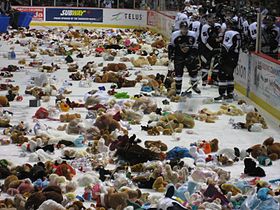
Where do all the bears come from?
It’s a phenomenon whose popularity has increased dramatically since its inception in 1993. I’m talking about hockey’s teddy bear toss. How did this happen?
The idea of the teddy bear toss is credited to marketing director Don Larson of the Kamloops Blazers (though the general manager of the Blazers later told ESPN that he thought the idea might have originated in Regina). A small mountain town in British Columbia, Canada, seems an unlikely place for the birth of what has become a proud tradition of hockey teams around the world, but what a birth it turned out to be. And what an adventure for teddies as they found another way to bring love and comfort to kids of all ages.
The first known teddy bear toss occurred on December 5, 1993 at a game between the Kamloops Blazers and Portland Winterhawks. It was a simple concept, actually. Fans were encouraged to bring teddy bears to the game and toss them on the ice at a designated time, which turned out to be the first goal by the home team Blazers. Larson didn’t know what to expect, and so was pleasantly surprised when over 2,400 stuffed animals, mainly teddy bears, rained down on the ice. The bears were then donated to local children to help them during the holidays.
And so it began, this teddy bear adventure.
The idea quickly spread throughout the Canadian Hockey League (CHL) and then into the United States where, although the National Hockey League (NHL) doesn’t allow the event due to concerns about player and fan safety, American Hockey League teams (mainly professional developmental teams for the CHL and NHL) has adopted it wholeheartedly. And the tosses have even spread overseas to countries such as Australia and Sweden.
Teddy bear tosses are generally held at December games, timed to coincide with the first goal made by the home team. If teams at first had concerns about fans’ reaction to the game stopping for upwards of 20 minutes while the bears are being collected, that concern soon waned as more and more fans got into the spirit of things. After all, who doesn’t love a teddy bear? And a teddy that can fly, even for a moment, is a wonder to behold. And don’t teddy bears and Christmas naturally go together?
No goals by the home team? That does happen sometimes. Which means getting creative. That’s what happened when the San Diego Gulls remained scoreless into the third period of their December 17, 2016 game against the Stockton Heat. Matt Savant, president of business operations for the Gulls was naturally stressed. How to give the teddies their moment of fame for the night? A solution was found, and during a timeout late in the period fans were instructed via a message on the scoreboard to let the bears fly.
Although it’s a fun event for fans and players alike, the teddy bear toss is serious business, bringing together hockey teams, businesses and philanthropists to help those in need. This is especially helpful to children in hospitals, schools and charities during a time of the year that is often difficult, the Christmas holiday season.
And it goes beyond just organizational participation. Many players get into the spirit as well, first having fun collecting the bears from the ice and then being involved in their distribution. Players also go to the hospitals to visit the children and hand out the bears. The players’ personal presence goes a long way toward cheering up the sick kids, not to mention the comfort the teddies bring their new humans.

The Hershey Bears of the American Hockey League hold the record for the most teddies thrown on the ice at a single event, collecting 25,017 teddies and stuffed animals on December 3, 2017 then beating their own record the next season on December 2, 1018 with 34,798 animals. That amounted to over three bears for every seat in the arena where they played! That’s a lot of teddies—and a lot of happy kids! In addition, philanthropists in Hershey (Pennsylvania) pledged a total of $1.00 per bear donated. That meant an additional $50,000+ for local charities. Everybody won.
And who would win more than the friendly teddy bear? They get to fly through the air to land unharmed on the ice, to be picked up by friendly hands. They then find new homes with humans they become fast friends with, humans that need the attention, love and warmth only a teddy can bring.
And let’s not forget the humans in this story. The fans get to share the holiday spirit with those less fortunate than themselves and have fun at the same time tossing the bears, the players get a good feeling by participating in distributing the teddies, and the kids receiving the bears get a friend for life just when they need one.
Hurray for the teddy bear toss! May it live long and prosper.
